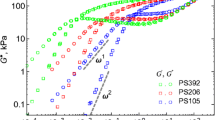Summary
The viscous properties of SBS block copolymers (of “Cariflex TR-1102” in this work) have been determined with the rate of shear being varied by 108 times. It has been shown that in the region of low shear rates the polymer behaves as a structured highly concentrated disperse system which exhibits sharply pronounced thixotropy. In the region of high shear rates, the viscous properties of the polybutadiene matrix are of decisive importance. At low values of shear stress the compliance of the SBS block copolymer exceeds that of the polybutadiene matrix almost by a decimal order.
At high shear stresses, just as in the case of viscous properties, the elastic behaviour of the SBS block copolymer approaches that of the polybutadiene matrix. Measurements of the dynamic characteristics at frequencies, which vary by a million times, most spectacularly point to the specificity of the viscoelastic properties over a wide temperature range. Under conditions of low temperatures the SBS block copolymer behaves as a rubber, while at temperatures above the glass transition temperature of polystyrene, at low loading intensities (low amplitudes and small deformations) the block copolymer shows low fluidity. This is most clearly seen from the frequency dependence of the loss modulus, especially in comparison with the relation typical of polybutadiene.
Zusammenfassung
Die viskosen Eigenschaften von SBS-Block-Copolymeren (hier „Cariflex TR-1102“) werden in einem Bereich von acht Zehnerpotenzen der Schergeschwindigkeit untersucht. Es wird gezeigt, daß im Bereich niedriger Schergeschwindigkeiten das Polymer sich wie ein strukturiertes hochkonzentriertes disperses System verhält, das eine ausgeprägte Thixotropie besitzt. Im Bereich hoher Schergeschwindigkeiten sind dagegen die viskosen Eigenschaften der Polybutadien-Matrix von entscheidender Bedeutung. Bei niedrigen Schubspannungswerten übersteigt die Komplianz des SBS-Block-Copolymeren diejenige der Polybutadien-Matrix höchstens um etwa 10%.
Bei hohen Schubspannungen nähert sich das elastische Verhalten analog wie bei den viskosen Eigenschaften demjenigen der Polybutadien-Matrix an. Die Messung der dynamischen Charakteristiken über einem Frequenzbereich von sechs Zehnerpotenzen lassen die spezifischen viskoelastischen Eigenschaften in einem weiten Temperaturbereich sehr deutlich erkennen. Bei tiefen Temperaturen verhält sich das Polymer wie ein Gummi, während bei Temperaturen oberhalb der Glasübergangstemperatur des Polystyrols unter geringer Belastung (d.h. kleinen Amplituden bzw. Deformationen) das Polymer eine geringe Fluidität zeigt. Dies erkennt man am deutlichsten an der Frequenzabhängigkeit des Verlustmoduls, insbesondere durch Vergleich mit derjenigen bei Polybutadien.
Similar content being viewed by others
References
Holden, G., E. T. Bishop, N. K. Legg J. Pol. Sci.26, 37 (1969).
Estes, G. M., L. S. Cooper, A. V. Tobolsky J. Macromol. Sci. Rev. Macromol. Chem.4, 313 (1970).
Sabsai, O. Yu., M. A. Koltunov, G. V. Vinogradov Mekh. Polimerov4, 750 (1972).
Vinogradov, G. V., N. V. Prozorovskaya Plastich. Massy5, 50 (1964).
Ulyanov, L. P., V. M. Neimark, Yu. G. Yanovsky, S. I. Sergeenkov Zav. Lab.11, 1402 (1973).
Vinogradov, G. V. Pure and Appl. Chem.39, 115 (1974).
Vinogradov, G. V., A. Ya. Malkin, Rheology of Polymers, Moscow, Khimiya, 1977, 438 pp. (in Russian).
Vinogradov, G. V., A. Ya. Malkin, E. P. Plotnikova, O. Yu. Sabsai, N. E. Nikolaeva Intern. J. Polymeric Matter.2, 1 (1972).
Kraus, G., J. T. Gruver J. Appl. Pol. Sci.11, 2121 (1967).
Keller, A., E. Pedemonte, F. M. Willmouth Kolloid Z. u. Z. Polymere238, 385 (1970).
Dlugosz, J., A. Keller, E. Pedemonte Kolloid Z. u. Z. Polymere242, 1125 (1970).
Aggarwall, S. L. Polymer17, 938 (1976).
Burkova, S. G. et al., Kauchuk i Rezina5, 26 (1973).
Malkin, A. Ya. Mekh. Polim.1, 173 (1975).
Cogswell, F. N., D. E. Hanson Polymer16, 936 (1975).
Malkin, A. Ya., S. A. Volfson, V. N. Kuleznev, G. I. Faidel, Polystyrene. Physico-Chemical Foundations of Production and Processing, Moscow, Khimiya, 1975 (in Russian).
Vinogradov, G. V., A. Ya. Malkin, V. G. Kulichikhin, in: Advances in Rheology of Polymers, Moscow, Khimiya, 1970, p. 181 (in Russian).
Kraus, G., K. W. Rollman J. Pol. Sci. Pol. Phys. Ed.14, 1133 (1976).
Meier, D. J. Polymer Preprints15, 171 (1974).
Ferry, J. D. Viscoelastic Properties of Polymers (Wiley, New York 1961).
Author information
Authors and Affiliations
Additional information
With 6 figures
Rights and permissions
About this article
Cite this article
Vinogradov, G.V., Dreval, V.E., Malkin, A.Y. et al. Viscoelastic properties of butadiene-styrene block copolymers. Rheol Acta 17, 258–263 (1978). https://doi.org/10.1007/BF01535062
Received:
Issue Date:
DOI: https://doi.org/10.1007/BF01535062




